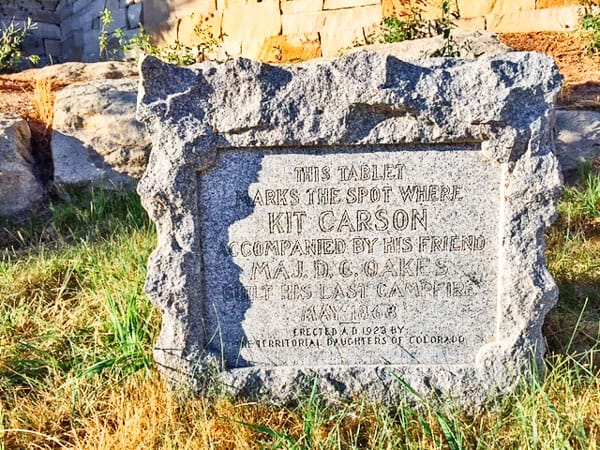Happy Canyon and other Wildcat Mountain lore

Article and photo by Joe Gschwendtner

Trapper, scout, Indian agent, soldier and authentic legend of the west, Kit Carson is one of the many who lived and died in these parts and make up the rich history of Castle Pines and Douglas County.
Wildcate Lore
Beginning this month, The Connection will be featuring a column titled “Wildcat Lore.” As it turns out, the Castle Pines Connection serves residents of the Wildcat Mountains, a name pioneers and historians gave to high country paralleling I-25 from Highlands Ranch and Lone Tree south to Castle Rock. Since the first territorial road (Daniels Park Road) bisected our mountains, there was no shortage of colorful characters parading through what are now private properties on the ridges of Douglas County. We plan to bring these grizzled and gutsy settlers alive again, vividly sharing their stories of grit and achievement in these Castle Pines.
Funny how these things go … I attended Peggy Cumming’s well-researched “Raising the Roots – A 150 Year History of Castle Pines” in late July at the Castle Pines Library. Within days, I became drawn into the fascinating history of these Wildcat Mountains.
Yep, we live in the Wildcat Mountains. It is a name early settlers gave to rolling, higher terrain south of Highlands Ranch including the ridges, cliffs, and buttes further south to Greenland and Larkspur. For Native Americans, the terrain offered meeting places, food, game and wood for tepees, weapons and corrals. One oddly positioned knoll (Round Top) located in today’s Happy Canyon neighborhood was a long-time signal post for tribes occupying the region. Our current properties were possibly all spoils of war as they were occupied by many regional tribes, including Utes, Arapaho, Pawnee, Apache, Sioux, Cheyenne and Kiowa.
The first Anglo adventurers included Zebulon Pike in 1806. Much later, several more thorough expeditions by John C. Fremont followed. In 1843, Fremont was guided by Kit Carson, who had earlier trapped here and married an Arapaho. Fremont named the signature landmark “Pound Cake Rock,” a name lasting until 1848 when one David Kellogg’s perspective prevailed with “Castle Rock.” Carson traversed our lands frequently thereafter, savoring his last campfire in Daniels Park in 1868. A stone plaque memorializing the event sits on the Sanctuary golf course maintenance road.
Late in 1858, small quantities of gold were discovered near Russellville, south of Franktown. Major D.C. Oakes, illustrious latecomer to that camp, co-published a booklet vastly stretching the facts about the Russellville find. Overnight an avalanche of humanity poured in, most of them fortune-seeking ruffians. When boom quickly turned to bust, all but a few moved on to another dream. Some sought to lynch Oakes on the way out.
“Busy body” Oakes somehow survived with a new shtick, sawmill operator. Location being everything, he planted his machinery at Blunt’s Elbow on the first territorial road (Daniels Park Road today), and across from Sylvester and Elizabeth Richardson’s ranch. Sylvester built or repaired wagons. Elizabeth, who was quite talented herself, provided guest accommodations at the ranch for stage travelers. Her beauty was also uncommon and so the lodge soon became known as the “Pretty Woman Ranch.”
The Homestead Act of 1862 and its later enhancements attracted a better class of pioneers. In 1874, Austrian immigrants and former Leadville miners John Schweiger and brothers brought cattle ranching and dry-land farming to Douglas County. Joseph Kroll, another Austrian took an identical path out of Leadville coal fields 11 years later. While the Schweiger Ranch remains today visible from I-25, the Kroll homestead once occupying the Glendale open space, is long gone.
An intermittent stream flowed through the Schweiger property from a no-name gulch when he took ownership. History has it that when asked the name of his ranch later on, John Schweiger answered “Happy Cañon” honoring “Happy Jack” Johnson, his best cowhand and whose beautiful morning singing was near legendary in the area.